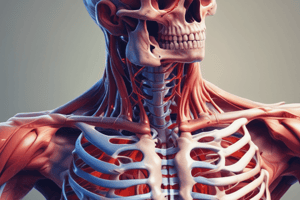Podcast
Questions and Answers
What is a joint?
What is a joint?
A point where two bones meet.
Which type of joint is characterized by little to no movement?
Which type of joint is characterized by little to no movement?
- Synovial Joints
- Cartilaginous Joints
- Fibrous Joints (correct)
- None of the above
Which of the following is an example of a synovial joint?
Which of the following is an example of a synovial joint?
- Teeth in the jaw
- Elbow joint (correct)
- Skull sutures
- Symphysis pubis
Fibrous joints have ____ movement.
Fibrous joints have ____ movement.
What type of muscle is under voluntary control?
What type of muscle is under voluntary control?
Smooth muscles are found in the heart.
Smooth muscles are found in the heart.
What is the main characteristic of cardiac muscles?
What is the main characteristic of cardiac muscles?
What type of muscle is spindle-shaped with single nuclei?
What type of muscle is spindle-shaped with single nuclei?
Which term of movement describes moving a limb away from the midline?
Which term of movement describes moving a limb away from the midline?
Match the terms of movement with their definitions:
Match the terms of movement with their definitions:
Osteoarthritis primarily affects small joints.
Osteoarthritis primarily affects small joints.
Flashcards
Fibrous Joint
Fibrous Joint
A joint where bones are connected by fibrous tissue, allowing little to no movement.
Cartilaginous Joint
Cartilaginous Joint
A joint where bones are connected by cartilage, permitting some limited movement.
Synovial Joint
Synovial Joint
A joint characterized by considerable mobility, a synovial fluid-filled cavity, and articular cartilage.
Skeletal Muscle
Skeletal Muscle
Signup and view all the flashcards
Smooth Muscle
Smooth Muscle
Signup and view all the flashcards
Cardiac Muscle
Cardiac Muscle
Signup and view all the flashcards
Flexion
Flexion
Signup and view all the flashcards
Osteoarthritis
Osteoarthritis
Signup and view all the flashcards
Uniaxial Joint
Uniaxial Joint
Signup and view all the flashcards
Polyaxial Joint
Polyaxial Joint
Signup and view all the flashcards
Study Notes
Joints and Muscular System
-
Joints are points where two or more bones meet
-
Joints are categorized by the material separating the bones: fibrous, cartilaginous, and synovial
-
Fibrous joints have no movement, separated by fibrous tissue
- Sutures (skull)
- Gomphosis (teeth)
- Syndesmosis (tibiofibular)
-
Cartilaginous joints have limited movement
- Primary (synchondroses): temporary cartilage, no movement (growth plates of long bones)
- Secondary (symphysis): permanent cartilage, limited movement (pubic symphysis, intervertebral discs)
-
Synovial joints have significant movement
- Articular surfaces are covered by cartilage
- Surrounded by a fibrous capsule
- Joint cavity with synovial fluid
- Types:
- Uniaxial: one axis of movement (elbow flexion/extension)
- Biaxial: two axes of movement (wrist flexion/extension, abduction/adduction)
- Polyaxial (ball and socket): multiple axes of movement (shoulder, hip)
- Plane: gliding movement (intercarpal joints)
Muscular System
- Three types of muscles: skeletal, smooth, and cardiac
- Skeletal muscles:
- Attached to bones, responsible for movement
- Composed of striated muscle fibers
- Voluntary control (somatic nervous system)
- Smooth muscles:
- In internal organs (digestive tract, blood vessels)
- Spindle-shaped fibers
- Involuntary control (autonomic nervous system)
- Cardiac muscles:
- In the heart
- Striated fibers, branched and interconnected
- Involuntary control, spontaneous contractions
Terms of Movement
- Flexion: bending
- Extension: straightening
- Abduction: movement away from midline
- Adduction: movement towards midline
- Circumduction: circular movement (combination of flexion, extension, abduction, adduction)
- Medial rotation: anterior surface faces medially
- Lateral rotation: anterior surface faces laterally
- Supination: palms facing forward
- Pronation: palms facing backward
- Inversion: sole of foot faces medially
- Eversion: sole of foot faces laterally
Studying That Suits You
Use AI to generate personalized quizzes and flashcards to suit your learning preferences.




